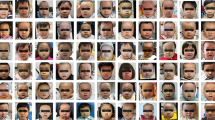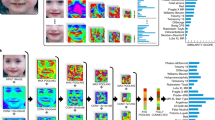Abstract
Turner syndrome (TS) is a chromosomal disorder disease that only affects the growth of female patients. Prompt diagnosis is of high significance for the patients. However, clinical screening methods are time-consuming and cost-expensive. Some researchers used machine learning-based methods to detect TS, the performance of which needed to be improved. Therefore, we propose an ensemble method of two-path capsule networks (CapsNets) for detecting TS based on global-local facial images. Specifically, the TS facial images are preprocessed and segmented into eight local parts under the direction of physicians; then, nine two-path CapsNets are respectively trained using the complete TS facial images and eight local images, in which the few-shot learning is utilized to solve the problem of limited data; finally, a probability-based ensemble method is exploited to combine nine classifiers for the classification of TS. By studying base classifiers, we find two meaningful facial areas are more related to TS patients, i.e., the parts of eyes and nose. The results demonstrate that the proposed model is effective for the TS classification task, which achieves the highest accuracy of 0.924 1.
摘要
特纳综合征是一种染色体异常疾病, 对女性病人的成长造成极大的危害. 及时诊断对该病患者具有重要意义. 然而, 现有的临床筛查方法相对耗时且费用昂贵. 相关研究人员提出使用机器学**方法进行特纳综合征诊断, 但是这些方法的诊断准确率有待提升. 因此, 面向特纳综合征诊断任务, 提出一种基于全局-局部人脸图像的双路径胶囊网络集成方法. 具体地, 对特纳综合征人脸图像进行预处理, 并在医疗专家的指导下, 将人脸图像分割为8部分具有医学意义的局部人脸图像; 然后, 基于完整人脸图像和8部分局部图像进行双路径胶囊网络模型训练, 以小样本学**方法解决模型训练过程中面临的样本不足问题; 最后, 以基于概率的集成方法对9个特纳综合征人脸分类模型进行集成. 通过对基础分类模型进行分析, 发现眼部区域和鼻子区域的异常面容与特纳综合征疾病具有**相关性. 实验结果显示, 该集成方法对特纳综合征诊断任务具有一定的有效性, 能够取得0.9241的最高诊断准确率.
Similar content being viewed by others
References
TURNER H H. A syndrome of infantilism, congenital webbed neck, and cubitus valgus [J]. Endocrinology, 1938, 23(5): 566–574.
GRAVHOLT C H, ANDERSEN N H, CONWAY G S, et al. Clinical practice guidelines for the care of girls and women with Turner syndrome: Proceedings from the 2016 Cincinnati International Turner Syndrome Meeting [J]. European Journal of Endocrinology, 2017, 177(3): G1–G70.
MARINO B, FINE K. Blueprints in Pediatrics [M]. 6th ed. Philadelphia: Lippincott Williams & Wilkins, 2013.
LIPPE B. Turner syndrome [J]. Endocrinology and Metabolism Clinics of North America, 1991, 20(1): 121–152.
JUNG M P, AMARAL J L, FONTES R G, et al. Diagnosis of Turner’s Syndrome: The experience of the Rio de Janeiro State Institute of Diabetes and Endocrinology between 1970 and 2008 [J]. Revista Brasileira De Saúde Materno Infantil, 2010, 10(1): 117–124 (in Portuguese).
BONDY C A. New issues in the diagnosis and management of Turner syndrome [J]. Reviews in Endocrine & Metabolic Disorders, 2005, 6(4): 269–280.
TABATABAEI S M, CHALECHALE A. Using DLBP texture descriptors and SVM for Down syndrome recognition [C]//2014 4th International Conference on Computer and Knowledge Engineering. Mashhad: IEEE, 2014: 554–558.
LEITE FILHO H P. Applicability of data mining technique using bayesians network in diagnosis of genetic diseases [J]. International Journal of Advanced Computer Science and Applications, 2013, 4(1): 47–50.
SONG W A, LEI Y, CHEN S, et al. Multiple facial image features-based recognition for the automatic diagnosis of Turner syndrome [J]. Computers in Industry, 2018, 100: 85–95.
YAO G H, LI J Q, PEI Y, et al. An automatic Turner syndrome identification system with facial images [M]//Frontier computing. Singapore: Springer, 2020: 105–112.
LIU L, SUN J C, LI J Q, et al. Automatic classification of Turner syndrome using unsupervised feature learning [C]//2020 IEEE International Conference on Systems, Man, and Cybernetics. Toronto, ON: IEEE, 2020: 1578–1583.
LI J Q, LIU L, SUN J C, et al. Diagnosis and knowledge discovery of Turner syndrome based on facial images using machine learning methods [J]. IEEE Access, 2020, 8: 214866–214881.
SABOUR S, FROSST N, HINTON G E. Dynamic routing between capsules [C]//31st Conference on Neural Information Processing Systems. Long Beach, CA: NIPS, 2017: 1–11.
WONG K C L, SYEDA-MAHMOOD T, MORADI M. Building medical image classifiers with very limited data using segmentation networks [J]. Medical Image Analysis, 2018, 49: 105–116.
KIM H G, CHOI Y, RO Y M. Modality-bridge transfer learning for medical image classification [C]//2017 10th International Congress on Image and Signal Processing, BioMedical Engineering and Informatics. Shanghai: IEEE, 2017: 1–5.
YIN S L, BI J. Medical image annotation based on deep transfer learning [C]//2018 IEEE International Conference on Internet of Things (iThings) and IEEE Green Computing and Communications (GreenCom) and IEEE Cyber, Physical and Social Computing (CP-SCom) and IEEE Smart Data. Halifax, NS: IEEE, 2018: 47–49.
CAI A H, HU W X, ZHENG J. Few-shot learning for medical image classification [M]//Artificial neural networks and machine learning — ICANN 2020. Cham: Springer, 2020: 441–452.
KIM M, ZUALLAERT J, DE NEVE W. Few-shot learning using a small-sized dataset of high-resolution FUNDUS images for glaucoma diagnosis [C]//2nd International Workshop on Multimedia for Personal Health and Health Care. Mountain View, CA: ACM, 2017: 89–92.
WEN G H, HOU Z, LI H H, et al. Ensemble of deep neural networks with probability-based fusion for facial expression recognition [J]. Cognitive Computation, 2017, 9(5): 597–610.
FINN C, ABBEEL P, LEVINE S. Model-agnostic meta-learning for fast adaptation of deep networks [C]//34th International Conference on Machine Learning. Sydney: PMLR, 2017: 1126–1135.
VINYALS O, BLUNDELL C, LILLICRAP T P, et al. Matching networks for one shot learning [C]//30th Conference on Neural Information Processing Systems. Barcelona: NIPS, 2016: 3630–3638.
Author information
Authors and Affiliations
Corresponding author
Additional information
Foundation item: the National Key R&D Program of China (No. 2020YFB2104402)
Rights and permissions
About this article
Cite this article
Liu, L. Ensemble of Two-Path Capsule Networks for Diagnosis of Turner Syndrome Using Global-Local Facial Images. J. Shanghai Jiaotong Univ. (Sci.) 28, 459–467 (2023). https://doi.org/10.1007/s12204-022-2491-9
Received:
Accepted:
Published:
Issue Date:
DOI: https://doi.org/10.1007/s12204-022-2491-9




